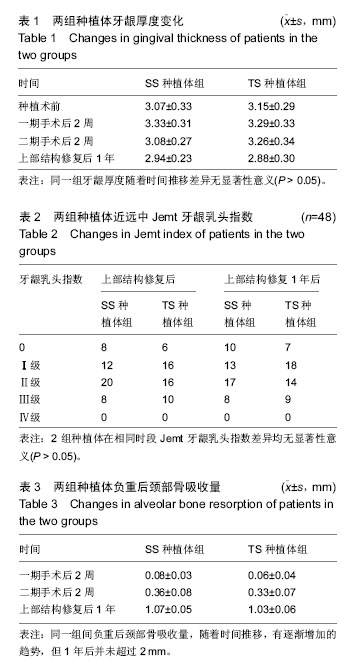中国组织工程研究 ›› 2016, Vol. 20 ›› Issue (38): 5703-5708.doi: 10.3969/j.issn.2095-4344.2016.38.012
• 组织工程口腔材料 tissue-engineered oral materials • 上一篇 下一篇
单颗固定种植修复后牙区牙龈:牙龈厚度、龈乳头和边缘骨吸收变化1年随访
张 宁1,王小兰2,李晓璐3,王晓信4,李红梅1,李昀生1
- 煤炭总医院,1口腔科,2妇产科,3肾内科,4理疗科,北京市 100028
Gingival changes in patients with single molar loss undergoing fixed implant restoration: a 1-year follow-up
Zhang Ning1, Wang Xiao-lan2, Li Xiao-lu3, Wang Xiao-xin4, Li Hong-mei1, Li Yun-sheng1
- 1Department of Stomatology, 2Department of Gynaecology, 3Department of Nephrology, 4Department of Physiotherapy, China Meitan General Hospital, Beijing 100028, China
摘要:
文章快速阅读:
.jpg)
文题释义:
口腔种植体:又称为牙种植体,还称为人工牙根。是通过外科手术的方式将其植入人体缺牙部位的上下颌骨内,待其手术伤口愈合后,在其上部安装修复假牙的装置。
两段式种植体:即种植体基台与固位体分为两段而不是一个整体的一类种植体。手术时,与骨组织结合的固位体和与牙龈组织结合的基台是前后分别进行2次手术植入完成的,而在基台与固位体两段之间是通过种植体中心螺丝将其相连成为一个整体。第1次手术先将固位体植入骨组织内,缝合伤口,经4-6个月待种植体固位体在完全无负载的休息状态下与骨组织产生骨结合后,再行2次手术,即切开牙龈组织,通过种植体中心螺丝连接基台,拆线后即可取模并完成最终修复体。
背景:埋入式种植体愈合期内完全埋植于软组织内,与口腔环境相隔绝,降低了潜在的感染因素,同时不受咬合力的影响,保证了种植体的骨结合。
目的:比较两段式埋入式和非埋入式种植体在不同手术方式条件下对口腔软组织恢复的影响。
方法:口腔后牙单颗固定种植患者24例,排除种植禁忌证,牙龈厚度大于1.5 mm,随机分为2组,分别采用奥齿泰SS和TS种植体组,SS种植体组采用非埋入式方式,而TS种植体组则采用两段式埋入方式,观察时间点为一期术后2周,TS种植体组二期术后2周,上部结构修复后和修复1年后观察项目有牙龈厚度,龈乳头和边缘骨吸收的变化。
结果与结论:①两组患者牙龈厚度,龈乳头和边缘骨吸收变化:在一期术后2周,TS种植体组二期术后2周,上部结构修复后和修复1年后差异均无显著性意义;②结果说明:两种手术方案对于软组织恢复和种植体稳定均无影响,临床上可根据患者具体情况选择相应的种植体置入。
中图分类号:

.jpg)